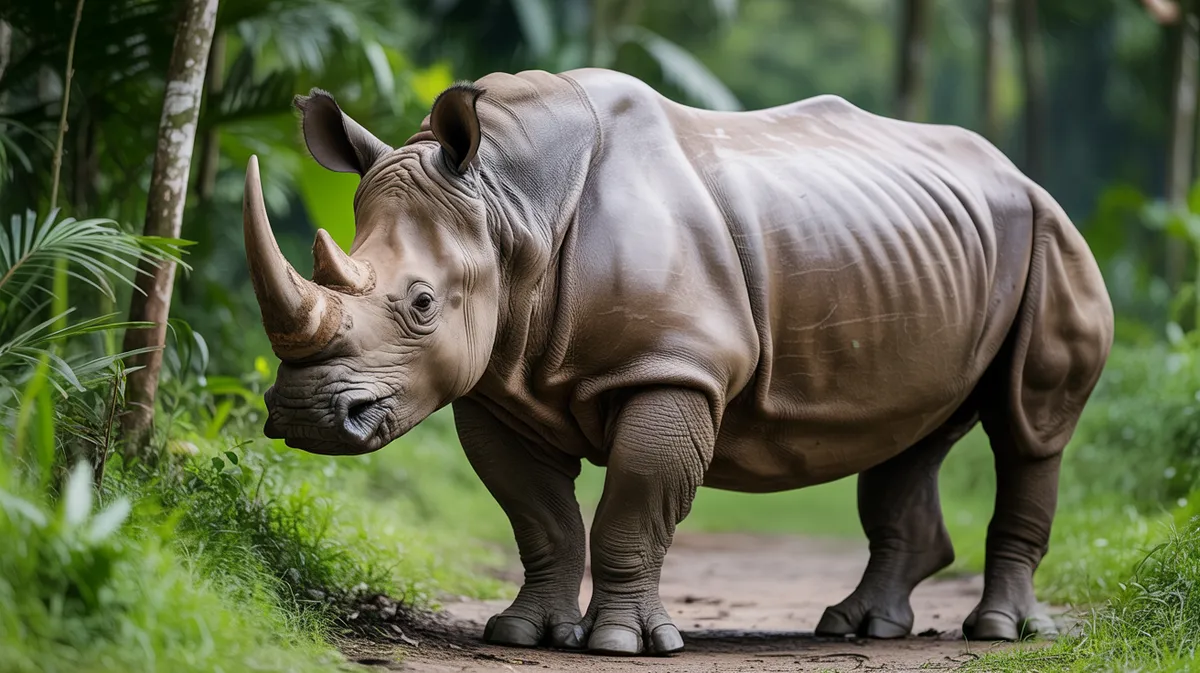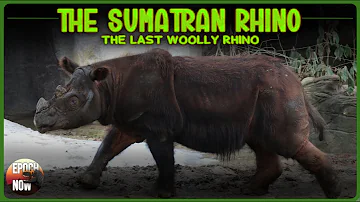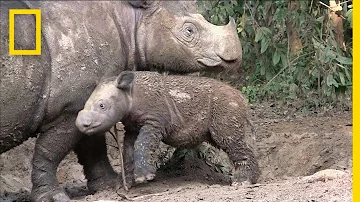
Sumatran Rhinoceros
Dicerorhinus sumatrensis

Meet the Sumatran Rhinoceros
The Sumatran rhinoceros is the smallest and hairiest of all rhino species, distinguished by its reddish-brown fur and two small horns. Native to dense mountain and lowland forests in Southeast Asia, it is critically endangered due to habitat loss and poaching. This elusive mammal is solitary by nature and is rarely seen in the wild. Its population has declined drastically, and only a few individuals survive in isolated pockets of Sumatra and Borneo.
Classification
Mammal
Habitat
Tropical rainforest
Diet
Herbivore
Lifespan
30-45 years
Conservation
Critically Endangered
Weight
500-1,000 kg
📖Fascinating Facts
Smallest Rhino Species
The Sumatran rhinoceros is the smallest of all living rhino species, standing just 1-1.5 meters tall at the shoulder.
Forest Dweller
It inhabits dense tropical rainforests and relies on thick vegetation for food and cover.
Ancient Lineage
This species is the most primitive of all rhinos, retaining many features of its prehistoric ancestors.
📋Detailed Description
The Sumatran rhinoceros (Dicerorhinus sumatrensis) is the smallest and most ancient of the extant rhinoceros species, standing 112–145 cm at the shoulder and weighing between 500–1,000 kg, with most adults averaging 700–800 kg. Its most distinctive feature is a dense covering of reddish-brown hair, which is especially prominent in calves and young adults but becomes sparser with age. The skin is thin and deeply folded, particularly around the neck and limbs, providing flexibility and protection in dense forest habitats. The species possesses two horns: a larger nasal horn, typically 15–25 cm long, and a smaller frontal horn, often less than 10 cm. Sumatran rhinos have excellent hearing and olfactory senses but relatively poor eyesight. Adapted to a solitary lifestyle, they are elusive and primarily crepuscular, active during dawn and dusk. Their home ranges are large, often exceeding 20 km², and they use mud wallows to regulate body temperature and deter parasites. The species is a browser, feeding on a wide variety of plant species, including leaves, twigs, fruit, and bark. Sumatran rhinos play a crucial ecological role as seed dispersers in their rainforest habitats. Their vocalizations are among the most diverse of all rhinoceroses, including whistles, squeaks, and grunts, which are used for communication, especially during mating and territorial disputes.
💡 Did you know?
Sumatran rhinoceroses are the closest living relatives to the extinct woolly rhinoceros due to their hairy bodies.
🔬Research & Sources
Wikipedia Summary
The Sumatran rhinoceros, also known as the Sumatran rhino, hairy rhinoceros or Asian two-horned rhinoceros, is a rare member of the family Rhinocerotidae and one of five extant species of rhinoceros; it is the only extant species of the genus Dicerorhinus. It is the smallest rhinoceros, although it is still a large mammal; it stands 112–145 cm (44–57 in) high at the shoulder, with a head-and-body length of 2.36–3.18 m and a tail of 35–70 cm (14–28 in). The weight is reported to range from 500–1,000 kg (1,100–2,200 lb), averaging 700–800 kg (1,540–1,760 lb). Like both African species, it has two horns; the larger is the nasal horn, typically 15–25 cm (5.9–9.8 in), while the other horn is typically a stub. A coat of reddish-brown hair covers most of the Sumatran rhino's body.
Last Modified: 5/25/2025
🎭Behavior & Social Structure
Sumatran rhinos are predominantly solitary, with individuals maintaining overlapping but exclusive territories marked by dung piles, urine spraying, and scraping the ground with their feet. They are highly secretive and avoid open areas, preferring dense forest cover. Daily activity peaks at dawn and dusk, with individuals spending midday hours resting in mud wallows or dense vegetation to avoid heat and insects. Feeding occurs throughout the day and night, with rhinos consuming up to 50 kg of vegetation daily, favoring pioneer plant species, figs, and wild mangoes. They are adept swimmers and can cross rivers with ease. Social interactions are rare outside of mating, but mothers are highly protective of calves, which remain with them for up to two years. Vocalizations, scent marking, and physical displays (such as horn rubbing on trees) are key communication methods.
👶Reproduction & Life Cycle
Sumatran rhinos are polyestrous, with females exhibiting estrous cycles of approximately 21–25 days. Mating is rare in the wild due to low population densities, but when pairs form, courtship can last several days and is characterized by vocalizations and mutual scent marking. Gestation lasts about 15–16 months, after which a single calf weighing 25–35 kg is born. Calves are born with a thick, woolly coat and are able to stand and walk within hours. Maternal care is intensive, with calves suckling for up to 16 months and remaining with the mother for up to two years. Females may breed again after the calf becomes independent, but interbirth intervals are typically 3–4 years. There is no fixed breeding season, though births may peak during periods of abundant food.
🛡️Adaptations & Survival
The Sumatran rhino's dense hair provides insulation and protection against insects and thorny vegetation, a trait retained from its Pleistocene ancestors. Its prehensile upper lip is highly flexible, allowing it to grasp and manipulate a wide range of plant material. The species' keen sense of smell and hearing compensate for its poor vision, aiding in navigation and predator avoidance in dense forests. Deep skin folds help channel water away and reduce parasite load. Their solitary and elusive nature reduces intraspecific competition and predation risk. Mud wallowing behavior is critical for thermoregulation and skin health, while their ability to traverse steep, rugged terrain and swim across rivers enables access to diverse habitats.
🎨Cultural Significance
Historically, the Sumatran rhino has held symbolic significance in local folklore and traditional medicine, particularly in Indonesia and Malaysia, where its horn was erroneously believed to possess medicinal properties. In some cultures, the rhino is considered a guardian of the forest and a symbol of strength and endurance. However, its elusive nature has limited its prominence in art and mythology compared to other large mammals. Conservation campaigns now emphasize its ecological importance and the urgent need for protection, often using the rhino as a flagship species for rainforest conservation.
🔬Recent Research & Discoveries
Recent research has focused on reproductive physiology, including hormonal monitoring and assisted reproductive technologies, to address low birth rates in captivity. Studies using camera traps and environmental DNA (eDNA) have improved detection and monitoring of wild populations. Genetic analyses have revealed significant divergence between Sumatran and Bornean populations, supporting subspecies distinctions and informing conservation management. Ongoing research at the Sumatran Rhino Sanctuary (Way Kambas, Indonesia) and Borneo Rhino Sanctuary (now closed) has yielded valuable insights into nutrition, health, and behavior. Notably, the first successful captive birth in over a century occurred in 2001, providing hope for ex situ conservation. Conservation genetics and disease management remain key research priorities.
🎥Wildlife Videos

The Sumatran Rhino | Wild Animals - Planet Doc Full Documentaries
In the rainforest of Borneo lives the Sumatran Rhino. This documentary shows us a unique rhinoceros specie: the woolly ...
Planet Doc Full Documentaries

Operation Sumatran Rhino Trailer
'Operation Sumatran Rhino', a wildlife conservation documentary on Sabah's do or die mission to prevent the extinction of the ...
Borneo Rhino Alliance

A Rhino's Life: Survival in the Jaws of Danger | 4K UHD Documentary
"A Rhino's Life" offers an immersive look into the world of one of the planet's most iconic creatures. Captured in stunning 4K UHD, ...
space and science

The World's Smallest Rhino is Going Extinct | Seven Worlds, One Planet | BBC Earth
With thanks to the International Rhino Foundation who supplied archive footage Watch more: Planet Earth ...
BBC Earth

The Sumatran Rhino: The Last Woolly Rhino
Deep in the forests of Island Indonesia lives a mysterious relic of a long gone age, a rhinoceros, but one unlike any others alive ...
Epoch Now

Sumatran Rhinos Are Nearly Gone—New Plan Launched to Save Them | National Geographic
#NationalGeographic #SumatranRhino #EndangeredSpecies About National Geographic: National Geographic is the world's ...
National Geographic
🌍Habitat Information
The Sumatran Rhinoceros typically inhabits Tropical rainforest environments. Sumatran Rhinoceross have adapted to their environments with specialized features and behaviors.
Primary Habitat:
Tropical rainforest
More detailed habitat information will be available soon.
🛡️Conservation Status
The Sumatran Rhinoceros is currently classified as Critically Endangered. Conservation efforts are crucial for preserving this species for future generations.
Common Threats:
- 🏠Habitat loss and fragmentation
- 🌡️Climate change impacts
- 🎯Hunting and poaching
- 🏭Human-wildlife conflict
⚠️Threats & Conservation Challenges
The Sumatran rhinoceros faces critical threats from habitat loss due to deforestation, agricultural expansion (notably oil palm and acacia plantations), and infrastructure development. Poaching for horns, despite limited market demand compared to African species, has historically contributed to population declines. Fragmentation of populations into small, isolated groups has led to inbreeding depression and reduced reproductive success. The current global population is estimated at fewer than 80 individuals, confined to a handful of protected areas in Sumatra and Borneo. Conservation challenges include difficulties in locating individuals for protection or breeding, low genetic diversity, and the species' complex reproductive biology. Recent extinctions in Malaysia highlight the urgency of coordinated international conservation efforts.
🔬Scientific Classification
Scientific Name
Dicerorhinus sumatrensis
Classification Hierarchy
🔍 About Taxonomic Classification
Taxonomic classification is a hierarchical system used by scientists to classify and organize living organisms based on shared characteristics and evolutionary relationships.
The system moves from broad categories (Kingdom) to increasingly specific ones, with each animal's scientific name typically consisting of its Genus and species.
📝Community Notes
Share your observations and insights about the Sumatran Rhinoceros with our community of wildlife enthusiasts.
Join Our Community
Sign in to share your observations and connect with fellow wildlife enthusiasts.
Sign In to ContributeNo community notes yet
Be the first to share your observations about the Sumatran Rhinoceros!
Explore Sumatran Rhinoceros
Select a tab above to learn more about this amazing animal.
📸Photo Gallery
No photos available for this animal yet.
🌟Discover More Wildlife
Continue your journey of discovery with more fascinating animals from our database
